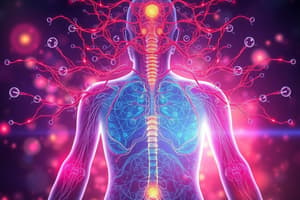Podcast
Questions and Answers
Which type of bone has higher mineral density in weight-bearing individuals?
Which type of bone has higher mineral density in weight-bearing individuals?
- Articular bone
- Trabecular bone (correct)
- Spongy bone
- Cortical bone
What is the consequence of energy deprivation in female athletes?
What is the consequence of energy deprivation in female athletes?
- Improved endurance
- Increased bone density
- Disruption of menstrual cycle and hormones (correct)
- Enhanced muscle growth
What is the effect of exercise on bone mass in old age?
What is the effect of exercise on bone mass in old age?
- Causes bone mass gain
- Has no impact on bone mass
- Accelerates bone mass loss
- Helps decrease bone mass loss (correct)
What is the myth about exercise and growth in children?
What is the myth about exercise and growth in children?
What is the primary cause of Osgood-Schlatter disease?
What is the primary cause of Osgood-Schlatter disease?
What type of bone experiences bigger loss in weight-bearing individuals during detraining?
What type of bone experiences bigger loss in weight-bearing individuals during detraining?
What type of muscle adaptation is associated with sarcopenia?
What type of muscle adaptation is associated with sarcopenia?
What type of training is associated with most of the cardiac adaptations?
What type of training is associated with most of the cardiac adaptations?
What is the potential effect of low total workload in resistance training?
What is the potential effect of low total workload in resistance training?
What is the potential effect of resistance training on blood pressure at rest?
What is the potential effect of resistance training on blood pressure at rest?
What is the primary cause of the 'Female Athlete Triad'?
What is the primary cause of the 'Female Athlete Triad'?
What is the effect of exercise on bone mass in middle age?
What is the effect of exercise on bone mass in middle age?
What is the result of PGC-1a stimulation?
What is the result of PGC-1a stimulation?
What are the effects of resistance training on lipid profile?
What are the effects of resistance training on lipid profile?
What does the sympathetic nervous system stimulate during exercise?
What does the sympathetic nervous system stimulate during exercise?
What is involved in energy production during exercise?
What is involved in energy production during exercise?
What does the endocrine response to exercise involve?
What does the endocrine response to exercise involve?
Which hormone plays a key role in blood flow control and remodeling during exercise?
Which hormone plays a key role in blood flow control and remodeling during exercise?
What is the effect of exercise on hormone levels (except insulin)?
What is the effect of exercise on hormone levels (except insulin)?
What do adipocytes release that affects fuel mobilization and appetite?
What do adipocytes release that affects fuel mobilization and appetite?
What happens to hormone levels and insulin sensitivity due to exercise?
What happens to hormone levels and insulin sensitivity due to exercise?
What are the effects of detraining on muscle size within Type 2 fibers?
What are the effects of detraining on muscle size within Type 2 fibers?
What are the effects of mTORC stimulation?
What are the effects of mTORC stimulation?
What is the role of the neuroendocrine system in exercise?
What is the role of the neuroendocrine system in exercise?
Flashcards are hidden until you start studying
Study Notes
Neuroendocrine System and Exercise: Key Points
- Concurrent exercise training shows attenuated strength increases compared to resistance training alone, but aerobic improvements are only slightly attenuated compared to endurance training alone
- PGC-1a stimulation results in increased mitochondria and mTORC stimulation results in strength increase
- Detraining retains strength adaptations and may lead to loss of muscle size within activity Type 2 fibers
- Resistance training decreases LDL-C, SBP, DBP, raises HDL-C, and has positive effects on metabolic syndrome/risk factors
- Neuroendocrine system involves neurotransmitters, hormones, nervous system, and pituitary gland
- Sympathetic nervous system increases heart rate and respiratory function, stimulates adrenal medulla, and enhances clot formation
- Energy production during exercise involves lipolysis and glycogenolysis
- Endocrine response to exercise involves hormone levels, receptors, and plasma levels
- Exercise plays a key role in fuel mobilization, blood flow control, and remodeling through hormones like testosterone, GH, and IGF
- Adipocytes release adipokines, leptin, and catecholamines, affecting fuel mobilization and appetite
- Exercise leads to decreased hormone levels (except insulin) and increased sensitivity to insulin, with changes in cardiovascular, muscle, and bone growth from growth hormone
- The endocrine system and training show attenuated metabolic responses, decrease in hormone levels (except insulin), and increased sensitivity to insulin, with decreased leptin levels.
Studying That Suits You
Use AI to generate personalized quizzes and flashcards to suit your learning preferences.




